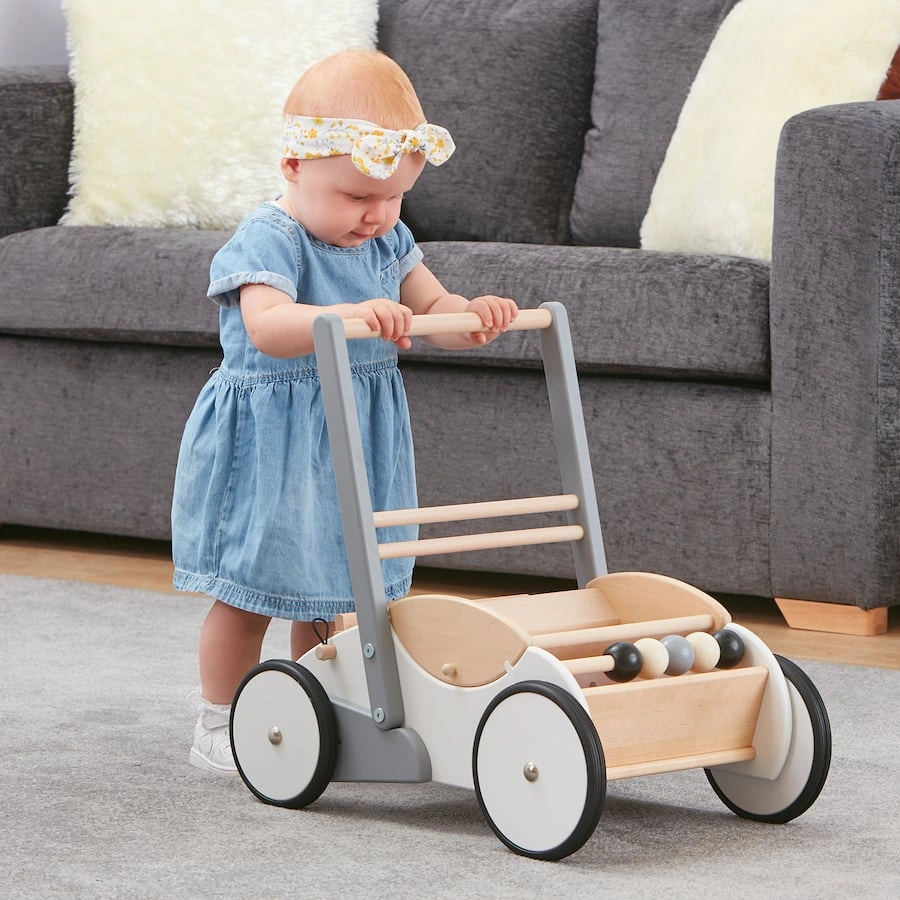
Overview
Wooden baby walkers have been a cherished tool for parents looking to support their baby’s first steps. These classic toys offer a unique blend of aesthetics, durability, and developmental benefits that plastic and metal alternatives often lack. In this comprehensive guide, we’ll delve into everything you need to know about wooden baby walkers—from their design and safety features to tips on choosing the perfect one for your child.
The Appeal of Wooden Baby Walkers
Wooden baby walkers combine timeless charm with practical functionality. Unlike their plastic or metal counterparts, wooden walkers are often crafted from sustainable materials and offer a sturdier, more reliable support system for babies learning to walk. Their natural finish and craftsmanship also add an elegant touch to any nursery.
Design and Features of Wooden Baby Walkers
Key Design Elements
- Materials Used: Wooden baby walkers are typically made from hardwoods like maple, oak, or birch. These woods are selected for their durability and resistance to wear and tear. Non-toxic, child-safe finishes ensure that the wood remains safe for babies.
- Safety Features: Safety is paramount when it comes to baby walkers. Look for features such as non-slip rubber wheels, smooth, rounded edges, and a stable base to prevent tipping. Many wooden walkers come with additional safety features like adjustable height settings to accommodate your baby’s growth.
- Adjustability: Modern wooden baby walkers often include adjustable height settings to ensure the walker grows with your child. This feature helps maintain proper posture and balance, enhancing the developmental benefits of walking.
Comparison with Plastic and Metal Walkers
While plastic and metal walkers are lightweight and often come with a range of built-in toys, wooden walkers stand out for their durability and environmental benefits. Wooden walkers are less likely to break under pressure, and their classic design often means they can be handed down to siblings or future generations.
Explore More Blogs: https://futuretrendz.co.uk/
Safety Considerations
Safety Standards and Certifications
When choosing a wooden baby walker, ensure it meets safety standards set by regulatory bodies such as the American Society for Testing and Materials (ASTM) and the Consumer Product Safety Commission (CPSC). Certified walkers are tested for stability, durability, and non-toxicity.
Common Safety Features to Look For
- Non-Slip Wheels: These prevent the walker from sliding too easily, which can reduce the risk of falls.
- Rounded Edges: Smooth, rounded edges minimize the risk of injury if your baby bumps into the walker.
- Stable Base: A wide base helps prevent tipping, providing a more secure support system for your baby.
Childproofing Your Wooden Baby Walker
Regularly inspect the walker for any loose parts or damage. Ensure that the finish is intact and that there are no splinters or rough edges. Keep a watchful eye on your baby whenever they are using the walker to ensure their safety.
Guidelines for Supervising Baby Walker Use
Limit the time your baby spends in the walker to short periods, as excessive use can delay motor skill development. Ensure the environment is free of obstacles that might cause tripping or falling.
Benefits of Wooden Baby Walkers

Environmental Impact and Sustainability
Wooden baby walkers are an eco-friendly choice. The use of sustainably sourced wood helps reduce the environmental impact compared to plastic walkers, which are often made from non-recyclable materials.
Durability and Longevity
Wooden walkers last because their robust construction withstands the rough and tumble of baby play, making them a worthwhile investment that you can use for multiple children.
Aesthetic Appeal and Customization
Wooden baby walkers come in various designs, allowing for a range of customization options. From natural wood finishes to painted designs, they can match any nursery decor. Many artisans offer personalized touches like custom engravings or unique paint designs.
Health and Developmental Benefits
Walking is a crucial developmental milestone. Wooden baby walkers provide a stable support that helps babies practice walking while developing balance and coordination. The added benefit of engaging with a tactile, wooden toy can also stimulate sensory development.
Choosing the Right Wooden Baby Walker
Factors to Consider
- Size and Weight: Make sure the walker fits your baby well; it should be light enough for them to handle easily while being sturdy enough to offer reliable support.
- Design and Features: Choose a design that aligns with your baby’s needs and your aesthetic preferences. Consider additional features like built-in toys or interactive elements.
- Top Brands and Models: Research reputable brands known for their safety and quality. Some top brands include Hape, Plan Toys, and Melissa & Doug.
Price Ranges and Value for Money
Wooden baby walkers range from $80 to $200, depending on the brand, design, and features. Higher-priced models often come with additional features or customization options. Evaluate the prices and features to ensure you are securing the best value for your purchase.
Reviews and Testimonials
Reading reviews from other parents can provide valuable insights into the performance and durability of different models. Look for reviews that discuss safety, ease of use, and overall satisfaction.
Maintenance and Care
Cleaning and Upkeep
Clean the wooden baby walker with a soft, damp cloth and gentle soap. Steer clear of strong chemicals that might harm the finish. Regularly inspect the walker for any indications of wear or damage.
Repair Tips
For minor repairs, such as fixing scratches or dents, use a wood repair kit. If you notice significant damage, consult the manufacturer or a professional for repair options.
Storage and Preservation
Store the walker in a dry, cool place when not in use. This helps preserve the wood and prevent warping or damage.
Explore More Blogs: https://futuretrendz.co.uk/
Alternatives and Comparisons

Overview of Alternative Baby Walkers
Alternatives to wooden walkers include plastic and metal walkers, as well as sit-to-stand walkers. Each type comes with its own benefits and drawbacks, which can influence your decision based on your specific needs and preferences.
Pros and Cons
- Plastic Walkers: Lightweight and often come with additional toys but may not be as durable or eco-friendly.
- Metal Walkers: Sturdy but can be heavy and less aesthetically pleasing compared to wooden walkers.
- Sit-to-Stand Walkers: Versatile and can be used in various stages of development but may lack the classic appeal of wooden walkers.
How Wooden Walkers Compare
Wooden walkers offer superior durability and aesthetic appeal. They also provide a more stable support system compared to some plastic models, making them a preferred choice for many parents.
User Experiences and Expert Opinions
Insights from Parents and Caregivers
Many parents appreciate the classic design and durability of wooden baby walkers. They often report that these walkers offer a stable and supportive environment for their baby’s first steps.
Recommendations from Experts
Child development experts recommend wooden baby walkers for their stability and developmental benefits. They also highlight the need to choose a walker that adheres to safety standards and is suitable for the baby’s age and size.
Case Studies and Real-Life Examples
Case studies show that babies using wooden walkers often achieve walking milestones earlier and exhibit better balance and coordination.
Conclusion
Wooden baby walkers offer a perfect blend of style, functionality, and developmental support. By considering design, safety, and maintenance, you can choose the best wooden walker for your baby’s needs. With their eco-friendly materials and classic appeal, wooden walkers are a worthy investment in your child’s early development.
FAQs
1. Are wooden baby walkers safe for my baby?
Wooden baby walkers are safe and provide excellent support for early walking as long as they meet safety standards and people use them with proper supervision.
2. How do I choose the right size wooden baby walker for my child?
Ensure the walker is adjustable and fits your baby’s height and weight. The walker should support their weight without tipping over and allow them to walk comfortably.
3. What materials are used in wooden baby walkers?
Most wooden baby walkers are made from hardwoods like maple, oak, or birch, and are finished with non-toxic, child-safe paints or varnishes.
4. How do I maintain and clean a wooden baby walker?
Clean with a damp cloth and mild soap. Regularly inspect for damage and ensure the finish remains intact. Store in a cool, dry place.
5. Can a wooden baby walker be used for multiple children?
Yes, wooden baby walkers are durable and can often be used for multiple children if properly maintained.







